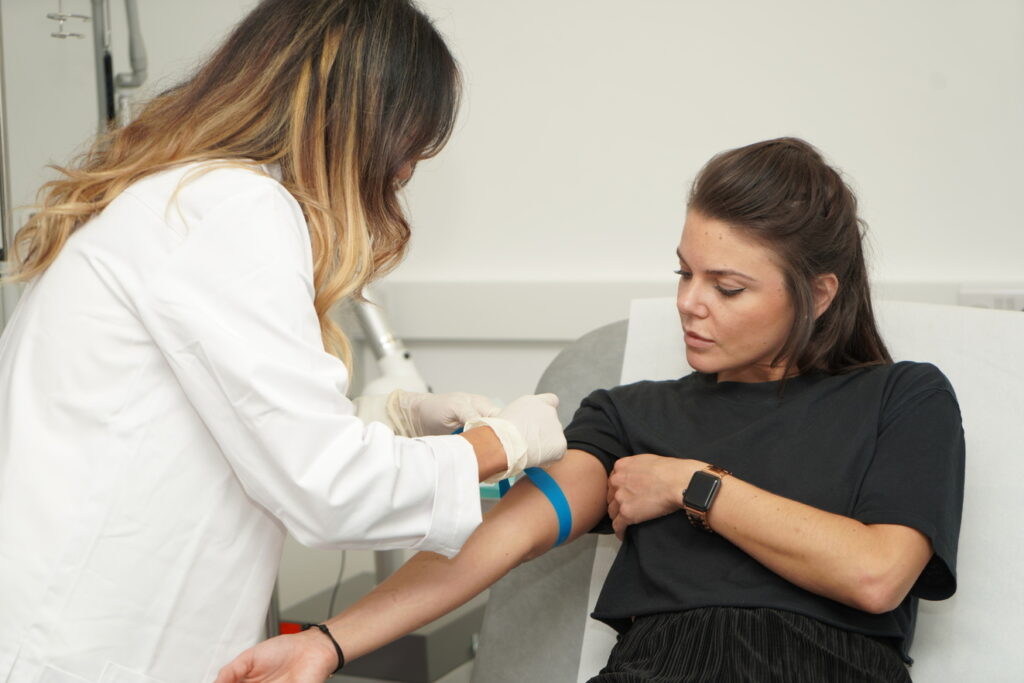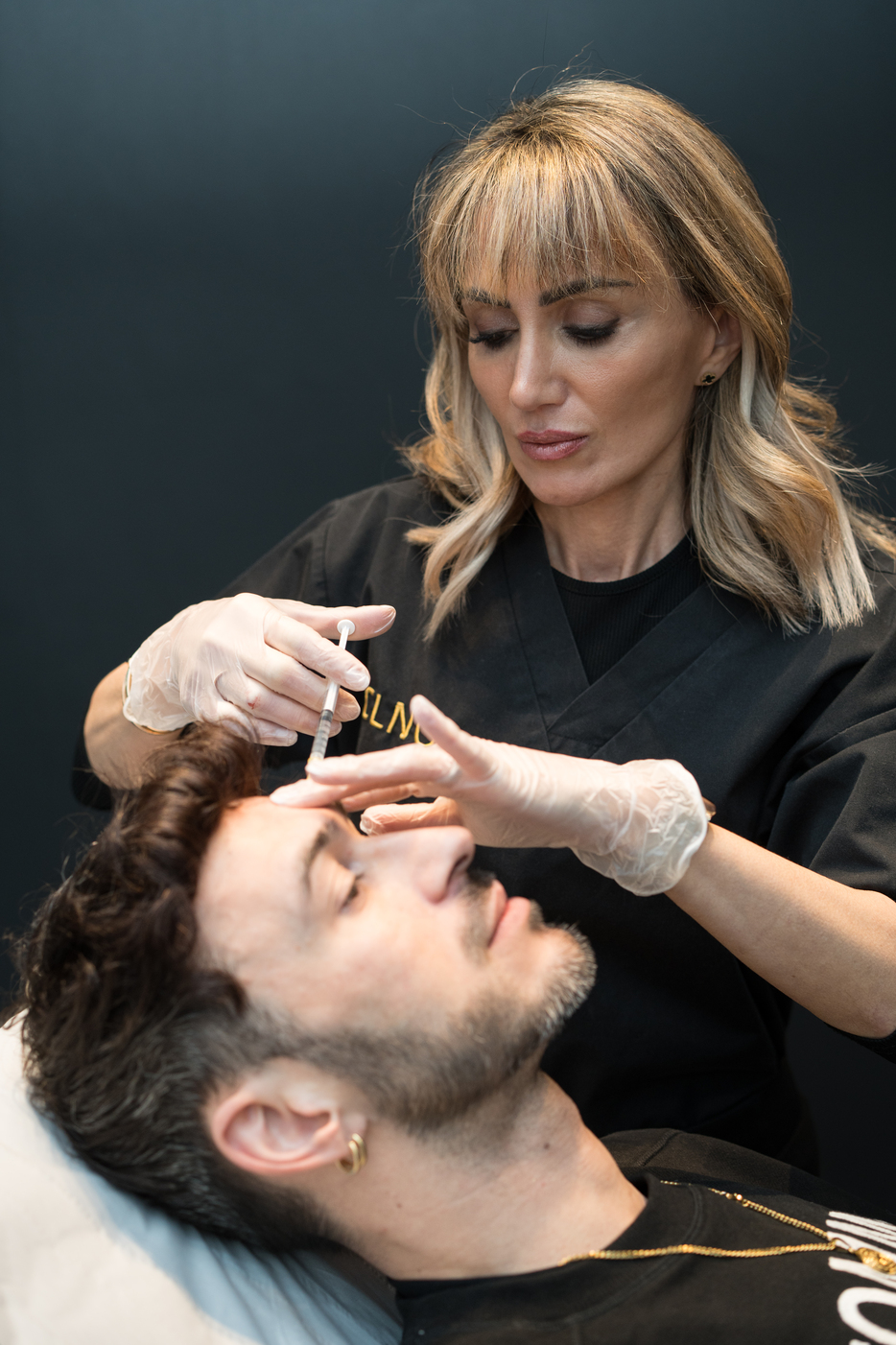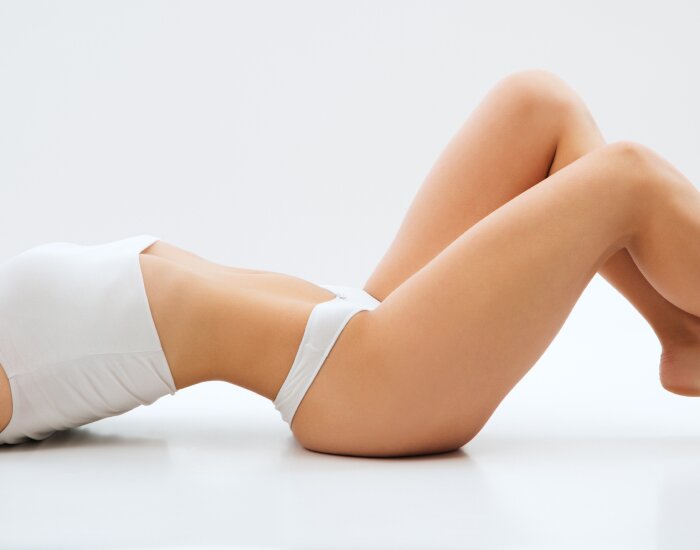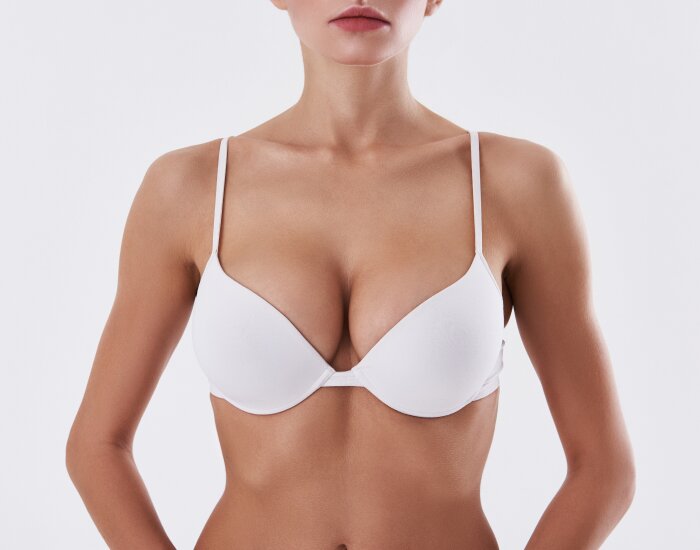Red Light Therapy
Photobiomodulation Manchester
Red light therapy, also known as photobiomodulation (PBM) or low-level light therapy (LLLT), uses specific wavelengths of red, blue and near-infrared light to stimulate the body’s natural healing and regeneration processes. It’s a completely non-invasive, painless treatment used in both medical and aesthetic settings to improve skin quality, reduce pain and inflammation, and support recovery and general wellbeing.
At CLNQ Manchester, we use a professional-grade LED light system that deliver clinically proven wavelengths between 480–940 nm. These wavelengths penetrate the skin to varying depths, influencing cellular energy (ATP) production, blood flow, and collagen synthesis, which together help to restore and rejuvenate tissues.
Table of Contents
What is Red Light Therapy?
Red light therapy — also known as photobiomodulation (PBM) — uses specific wavelengths of visible red, blue and near-infrared (NIR) light to trigger beneficial biological responses in your cells. It’s painless, non-thermal and drug-free. At CLNQ, we offer medical-grade LED PBM as a stand-alone treatment and as an adjunct to aesthetics, sports recovery, and wellness programmes.
Photobiomodulation is a form of light therapy using non-ionising (low-energy) light sources such as LEDs or low-level lasers in the red and near-infrared range. Unlike ablative lasers or intense pulsed light (IPL), PBM does not heat or damage tissue. Instead, it triggers photochemical effects inside cells that can reduce inflammation, modulate pain and support tissue repair. Professional bodies describe PBM as a non-thermal process that elicits photophysical and photochemical events in biological tissues.
The leading theory is that red/NIR photons are absorbed by mitochondrial chromophores — most notably cytochrome-c oxidase (CCO) in the respiratory chain. This interaction appears to:
Improve mitochondrial efficiency, increasing cellular ATP (your cell’s energy currency).
Release bound nitric oxide (NO) from CCO, which may improve microcirculation and oxygen delivery.
Modulate reactive oxygen species (ROS) and downstream cell signalling, influencing inflammation and repair genes.
Because near-infrared light penetrates deeper than visible red, NIR (e.g., ~810–850 nm) is often selected for musculoskeletal and joint applications, while red (e.g., ~630–660 nm) is frequently used for skin. Penetration depth and target tissues vary with wavelength and dose.
What are the benefits of red light therapy
There are numerous potential benefits of red light therapy. These include:
Boosts Cellular Energy (ATP Production) – Red and near-infrared wavelengths stimulate mitochondria to produce more ATP, fuelling the body’s natural repair and regeneration processes. This helps improve cell function, recovery, and overall energy levels.
Promotes Skin Rejuvenation and Collagen Production – Light at 630 nm and 660 nm penetrates the skin to activate fibroblasts, increasing collagen and elastin synthesis. This results in smoother, firmer, and more youthful-looking skin.
Reduces Inflammation and Aids Recovery – By improving microcirculation and reducing oxidative stress, red light therapy helps calm inflammation throughout the body. It can relieve pain, stiffness, and swelling in muscles and joints.
Accelerates Wound Healing and Tissue Repair – The therapy increases blood flow, oxygen delivery, and collagen remodelling in healing tissues. It’s ideal after injury, surgery, or cosmetic treatments to speed up recovery and minimise scarring.
Supports Hair Growth and Scalp Health – Red light energy enhances blood flow and cellular metabolism in the scalp, re-energising dormant follicles. Regular use can help improve hair thickness, density, and overall scalp condition.
Improves Mood, Sleep and General Wellbeing – Red and near-infrared light help balance circadian rhythms and reduce fatigue by optimising mitochondrial efficiency. Many users report better sleep quality, higher energy, and a calmer mood.
Red Light Therapy
Red light therapy or photobiomodulation has been used for many conditions. Below are some of the main applications supported by clinical evidence. The research in the use of red light therapy continues to grow and CLNQ we aim provide the most innovative evidence based treatments.
Skin Rejuvenation and Anti-Ageing
Red light therapy has been widely used to rejuvenate ageing or sun-damaged skin. It stimulates fibroblast cells to produce new collagen and elastin, improving skin firmness and reducing fine lines and wrinkles. Studies show measurable improvements in wrinkle depth, elasticity, and overall texture after a course of LED treatments.
At CLNQ, we often combine red light therapy with treatments like HydraFacial, microneedling, or radiofrequency for a synergistic effect. Clients describe their skin as looking brighter, plumper, and healthier — with a natural glow.
A randomised trial published in Lasers in Surgery and Medicine found that 633 nm red LED therapy improved dermal density and reduced wrinkle depth over 12 weeks, with continued collagen remodelling up to 3 months after treatment.
Wound Healing and Scar Recovery
Red and near-infrared light accelerate wound healing by enhancing blood flow, stimulating fibroblast activity, and increasing collagen production. This makes it valuable after surgical procedures or injuries.
At CLNQ, many post-operative patients benefit from LED therapy after surgery to improve scar appearance and promote faster recovery. It can also assist chronic wound healing such as diabetic ulcers or venous leg ulcers under medical supervision.
A 2024 meta-analysis of 18 randomised trials found red light therapy significantly improved wound closure rates and reduced pain compared with control groups.
Pain Relief and Musculoskeletal Conditions
Photobiomodulation has been studied for joint pain, arthritis, tendinopathies, and chronic back or neck pain. By reducing inflammation and promoting microcirculation, red light therapy can provide drug-free pain relief for many musculoskeletal conditions.
It can be used as part of a comprehensive pain management and recovery plan for conditions such as:
Osteoarthritis (knees, hands, hips)
Tendon injuries (Achilles, rotator cuff)
Post-exercise muscle soreness
Fibromyalgia and chronic pain syndromes
Red light reduces levels of pro-inflammatory cytokines (IL-6, TNF-α) and modulates nerve conduction, which helps decrease pain sensitivity. It also increases nitric oxide, improving local blood flow and nutrient delivery.
A systematic review of 11 RCTs found red light therapy effective in reducing chronic pain and inflammation, particularly when combined with physiotherapy or exercise.
Sports Recovery and Performance
Athletes use red and near-infrared light to enhance muscle recovery, reduce inflammation, and improve endurance. By improving mitochondrial energy production and decreasing oxidative stress, PBM can shorten recovery time between workouts and reduce delayed-onset muscle soreness (DOMS).
At CLNQ, we integrate red light therapy into longevity and athletic recovery programmes alongside IV vitamin therapy and hyperbaric oxygen therapy. Many clients — from recreational gym-goers to professional athletes — report feeling less stiff and fatigued after intense training.
A 2024 Frontiers in Sports and Active Living review concluded that photobiomodulation may improve muscle strength recovery and endurance when used pre- or post-exercise, with optimal wavelengths between 630–850 nm.
Hair Loss and Thinning
Low-level laser therapy (LLLT), a form of red light therapy, can help stimulate hair growth in both men and women with androgenetic alopecia (pattern baldness). It prolongs the hair follicle growth phase (anagen), increases blood flow to the scalp, and improves cellular metabolism within follicles.
At CLNQ, we offer red light therapy as part of our hair restoration protocols, often in combination with PRP injections or exosome therapy. This integrated approach enhances follicle activity and promotes thicker, healthier hair growth.
Clinical studies show regular red light treatments (630–670 nm) can increase hair count and thickness within 12–24 weeks. Results are comparable to topical minoxidil in some studies.
Post-Surgical Healing and Recovery
After cosmetic or reconstructive surgery, red light therapy can aid in reducing swelling, improving scar appearance, and speeding up tissue recovery. It helps manage post-inflammatory reactions, encourages better lymphatic drainage, and supports collagen remodelling during healing.
At CLNQ, many patients undergoing facelifts, eyelid surgery, tummy tucks, or breast procedures use LED therapy as part of their aftercare plan. The treatment is completely safe to use once incisions have closed.
Mood, Sleep, and Seasonal Affective Disorder (SAD)
Beyond physical health, red light therapy may influence circadian rhythm regulation and neurotransmitter balance. Exposure to near-infrared light in the morning can enhance alertness, improve mood, and may help regulate sleep patterns.
Early studies suggest benefits for people with seasonal affective disorder, mild depression, or sleep disruption caused by shift work or screen overexposure. Sessions may be paired with lifestyle coaching to support healthy sleep–wake cycles.
Neurological Health and Cognitive Function
Emerging research into transcranial photobiomodulation (tPBM) explores how near-infrared light may improve brain function, memory, and mental clarity by enhancing mitochondrial efficiency and cerebral blood flow. While still experimental, it shows promise in conditions such as mild cognitive impairment, post-concussion syndrome, and age-related cognitive decline.
Research demonstrated that just three minutes of deep red 670 nm light exposure improved colour vision and retinal function in older adults, suggesting potential neuroprotective effects.
Rosacea, Eczema, and Psoriasis
Red light therapy can calm chronic inflammatory skin conditions. In rosacea, it helps reduce facial redness, flushing, and inflammation by stabilising blood vessels and modulating the immune response. For eczema and psoriasis, it supports barrier repair and reduces itching.
Red light therapy Manchester is often used between flare-ups to maintain remission and reduce reliance on topical steroids. It’s gentle enough for even the most sensitive skin types.
Longevity
Red light therapy for longevity refers to using PBM to support cellular energy production, reduce low-grade inflammation, improve sleep and recovery, and maintain function as we age. The mechanistic rationale comes from mitochondrial and vascular effects noted above. At CLNQ Longevity Clinic Manchester, we frame PBM as a low-risk, wellness-adjacent tool that may support healthy ageing behaviours — movement, nutrition, sleep and stress management — rather than a stand-alone anti-ageing solution.
Red Light Therapy FAQ
Frequently Asked Questions
Is red light therapy safe for all skin types?
Yes. PBM is non-thermal and does not rely on melanin contrast, making it suitable for all Fitzpatrick skin types when used correctly.
Can red light help acne?
PBM can reduce inflammation and support healing. We often combine it with medical-grade skincare, lifestyle advice and, where appropriate, other light-based therapies. It is not a replacement for prescription acne care when that is indicated.
Does red light therapy burn the skin?
No. Red light panels use non-UV light, so they do not burn or tan the skin. They provide gentle, therapeutic wavelengths only.
Can red light be used with other treatments?
At CLNQ, we use red light as part of a package combined with other treatments such as PEMF, vitamin drips,IV NAD, hyperbaric oxygen and ozone.
What are the risks of photobiomodulation?
Red light therapy, also known as photobiomodulation, is generally considered very safe when performed correctly using medical-grade devices. The treatment is non-invasive, non-thermal, and does not damage the skin. However, mild and temporary side effects can occasionally occur, such as slight redness, dryness, or sensitivity immediately after treatment. Overuse or exposure to excessively high light intensity can sometimes cause skin irritation or headaches. Eye protection should always be worn, as direct exposure of the eyes to intense LED or laser light can be harmful. People who are pregnant, have active skin cancer, photosensitive conditions, or take photosensitising medications should avoid treatment unless medically advised. When performed under professional supervision, the risks of red light therapy are minimal.
How much is red light therapy Manchester?
The cost of red light therapy depends on a number of factors such as duration and number of sessions. At CLNQ, the price for red light therapy is from £50.
Confident. Beautiful. Empowered.
The Leading Aesthetic and Longevity Clinic in Manchester and Cheshire
We are dedicated to helping you achieve your health and wellness goals through our comprehensive range of personalized treatments and luxury approach. Whether you’re seeking to address specific concerns, enhance your appearance, or simply optimize your well-being, we have the solution. Our team of experts is passionate about creating a welcoming and supportive environment where you can feel comfortable and confident in your journey to a more radiant you. Don’t wait any longer to start your journey to optimal health and beauty.

















